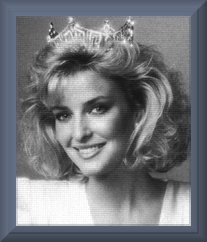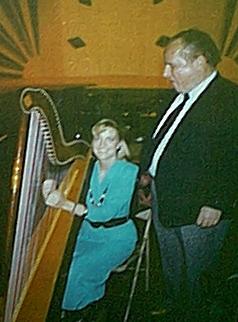


HOW THE HARP HELPED ONE YOUNG WOMAN BECOME MISS AMERICA
Sharlene Wells was chosen Miss America of 1985 and her talent featured her playing the Paraguayan harp. The
following is based on an interview with Sharlene Hawkes in 1998 by Earl Tessman (Tacho Guazu)
Sharlene’s father was living in Asuncion, Paraguay, when his wife was killed. He had three children. Her own mother
had one child and then the two of them got married and she was born in Asuncion, Paraguay in 1964.
She then had
two brothers and two sisters, and they were all like one happy family. When she was six months old, they moved to
Cordoba, Argentina, at age three, they moved to Ecuador, at age four, they moved to Mexico, at age seven, they
moved to Utah, at age 12, they moved to Chile, at age 13, they moved to Buenos Aires, Argentina, at age 17, they
moved back to Salt Lake City, Utah.
Her father worked for City Bank and when she was 12, he was asked to become a full time missionary for The Church
of Christ of Latter-day Saints. When she was a thirteen-year-old teenager in Buenos Aires, she started playing the
harp, based on a trip she took with her father to Asuncion, Paraguay. He took her to a place called the "Jardin de la
Cerveza," known as
"The Beer Garden," where they have marvelous floor shows. She was intrigued by the harp playing and the bottle
dancing, so she asked her father if she could learn to play the harp. They purchased a harp and returned to Buenos
Aires. She found an instructor to teach her the harp. His name was Baez Irala. He was a Paraguayan and it was a
tremendous task for him to get to her home. It would take him two hours and he had to ride a train and then a bus to
find her. He would teach for an hour and then go back to his house. He would play her harp and then has her play
what he had just demonstrated. She learned by ear only and followed his instructions. Most Paraguayan music is
not written and the music is learned by ear only, by intent listening. The only other instructor she had was in Salt
Lake City, from a returned missionary, Steve Allen, who had learned to play while on a mission for the church in
South America. He helped her prepare for the Miss America Pageant.

Sharlene’s mother was a concert pianist and she had all of her children trained on the piano, to differing degrees.
Each one started early on the piano. She got to go to college at Brigham Young University. She also played other
instruments, the trumpet in the school bank, learned some guitar, did a lot of singing. When she was 18, she won the
"Overall Creative and Performing Arts" award at America’s Junior Miss Pageant. The award was $5,000, and she
won a total of $13,000. That is the reason she decided to continue with the harp for the Miss America Pageant.
She
entered the other pageants, namely , in 1983, the Miss Salt Lake Valley and the Miss Utah, in which she placed
second. The next year she won Miss Salt Lake Valley, Miss Utah, and eventually Miss America of 1985. She decided
to play the Paraguayan harp for her talent, instead of the piano, which was her forte. She decided on the harp
because it was unique. She went to the Nationals and won the overall talent award. At 18, she played some
professional engagements, at the Marriott Hotel, for weddings and receptions, and for the Church. This gave her
some cash to help with college. She graduated from BYU in 1988, with a degree in Communications
The way in which the Paraguayan harp helped her with the Miss America pageant, was that it was so different and it immediately caught everyone’s eye, ear, and attention, in addition to being from South America. Everyone asked her "What’s your story?" For the pageant, she played a fast version of "Llegada," meaning "The arrival," but her featured song was "Mis Noches Sin Ti," meaning "My nights without you." This is a sad song of longing, but has a beautiful melody and is impressive. She sang it in Spanish and no one could tell what it was about. She sang it as if it were a happy song, as a sad song would not do in this pageant. She played it with a happy face and a happy smile, and no one knew the difference.
For the pageant, she took two harps, made by Sanabria in Asuncion, Paraguay. One was for the stage and one for
her hotel room to practice. She did not take any harps on her year-long tour, due to the cumbersome cases involved.
Sharlene went to five cities per week for a year. She traveled 250,000 miles in one year, equivalent to ten times around
the world. If she had only played the piano, she did not believe she would have stood out as much. She believes
playing the Paraguayan harp made her stand out and helped her become Miss America.
Sharlene playing on one of Tacho's harps

The Paraguayan harp has a distinctive tone and people were not used to a harp sounding like this. They were
amazed at the beautiful sound the Paraguayan harp develops. The people were not used to hearing a harp played so
fast and with so much energy, and were very surprised at what the harp could do and the techniques the
Paraguayan’s use. They had been used to hearing a harp just plucking along and were amazed at the difference in
the speed and techniques involved. Music can be created to sound like guitars, basses, percussion instruments, and
several other instruments. It is surprising what this harp and the players can do with it.
Sharlene wore a very fancy outfit that looked very native, but was not attributable to Paraguay or any other country.
She had a beautiful wide full skirt, with a white blouse with lots of sequins. It was a real stage outfit.
After her reign, she went back to BYU, as she had two years left, met her current husband, got married and they both
graduated from the University. After they graduated, they went back east and Sharlene took a full-time job with
ESPN, the sports network, as a sports broadcaster and commentator, while her husband continued in school. After
two years back east, they moved back to Utah and Sharlene signed a 5-year contract with ESPN on a part time basis.
Once children started coming, it became difficult for her to honor that, so three years ago, (1995), she went freelance
and is only doing events such as the Kentucky Derby, the Preakness, and occasional things on ESPN. They have
four children. The youngest is one year old. Her husband, Bob Hawkes, is a physical therapist and has his own
clinic in Bountiful, Utah, nearby where they live. Their oldest child is eight years old and is learning the violin. She is
training all their children on the piano and also on the violin.
She is now switching gears to get away from appearing on TV so much, limiting it to three or four days a month, at the most. She is a professional speaker for Corporate clients etc. She speaks about motivational subjects, etc. More appearances than that and the family starts rebelling. She can now control her own schedule. She plays the harp occasionally, at Church, for family, Christmas and other occasions.

After the pageant, the President of Paraguay, Alfredo Stroessner, invited Sharlene to Paraguay to honor her role of
Miss America. She got the Royal treatment. They rolled out the red carpet on the steps of the airplane ramp. They
had a full Paraguayan band there to serenade her. They had a full formal State dinner at the Pink House, which is the
Presidential palace. All the notables of the country were there and they asked her to play her harp for them. She was
reluctant to do so as their own harp players were so much more talented, in her mind, than she was. She played and
they were very enthusiastic and they loved it very much. To recognize the Paraguayan harp, the Paraguayan’s
played the Miss America pageant seven times on National TV. They were very excited about the fact that someone
would recognize the importance of their harp. They are very proud of their culture and the harp.
The harp is the national instrument of Paraguay and they have a rule that any radio or TV station that has a licence
in Paraguay, must broadcast at least one hour of harp music per day to retain that licence. You can tune into the
radio or TV as you are going to bed and are usually able to hear Paraguayan harp music.
The Paraguayans, including myself and all harp lovers, thank Sharlene for exposing the beauty of the Paraguayan harp, including their music, their playing techniques, and the amazing sound of the harp itself.
This article was written by Earl Tessman (Tacho Guazu)


LINKS



